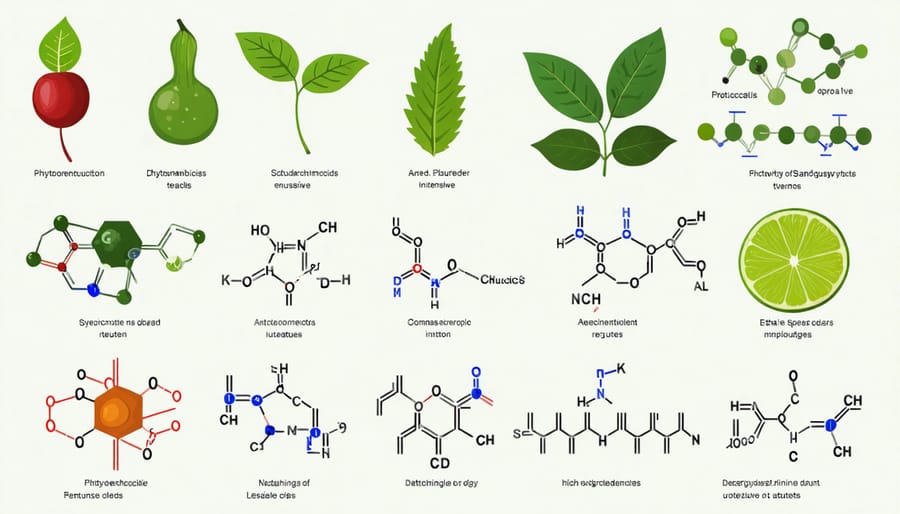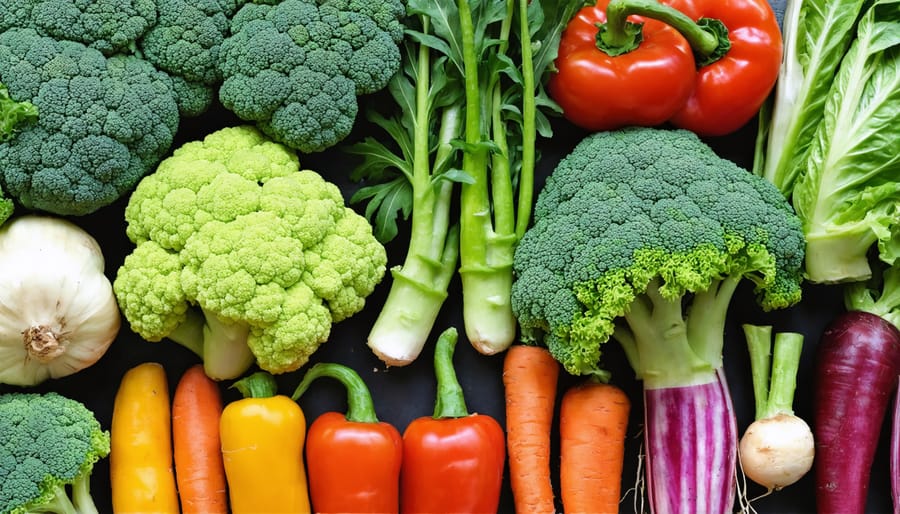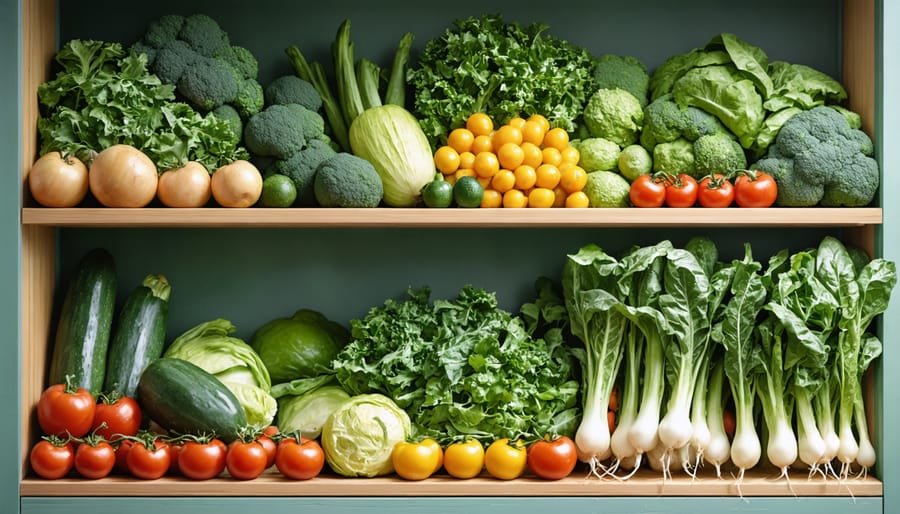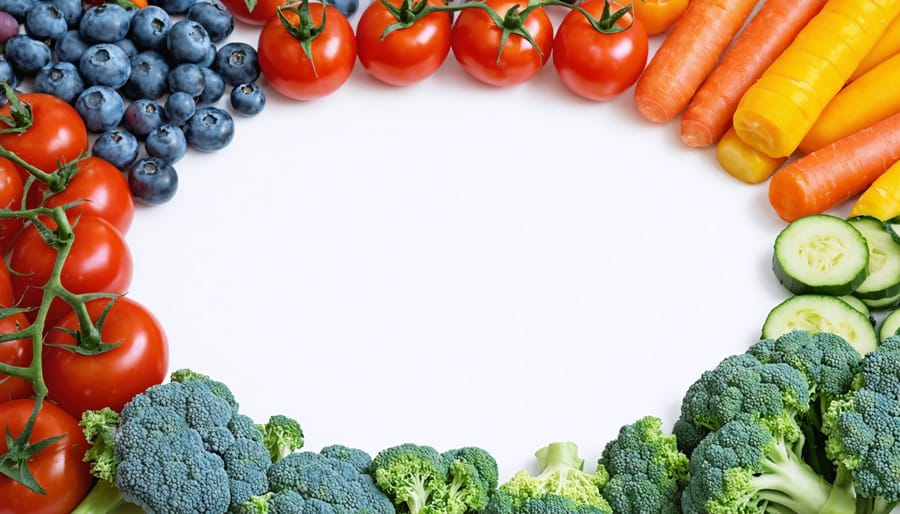Every colorful fruit and vegetable on your plate contains powerful plant compounds that can transform your health. These natural chemicals, called phytochemicals, do far more than create vibrant reds in tomatoes or deep purples in blueberries – they’re nature’s defense system against disease. Scientists have identified thousands of these compounds, from the lycopene that gives tomatoes their cancer-fighting properties to the anthocyanins that make blueberries a brain-boosting superfood. While vitamins and minerals have long been celebrated as essential nutrients, phytochemicals are now emerging as equally crucial players in preventing chronic diseases, supporting brain health, and slowing the aging process. The good news? These powerful compounds are abundant in common foods you probably already enjoy, from your morning cup of green tea to the garlic and onions in your evening meal. Understanding how to harness the power of phytochemicals through everyday food choices can be your key to better health.
What Are Phytochemicals?

How Phytochemicals Protect Your Health
Phytochemicals work as your body’s natural defense system, helping to protect your long-term health in multiple ways. These powerful plant compounds act as antioxidants, fighting harmful free radicals that can damage cells and lead to various health issues. They also support your immune system, reduce inflammation, and may help prevent chronic diseases like heart disease and certain cancers.
Different phytochemicals offer unique protective benefits. For example, lycopene in tomatoes supports heart health, while anthocyanins in berries help maintain brain function. Glucosinolates, found in cruciferous vegetables, assist your body’s natural detoxification processes. Flavonoids, present in colorful fruits and vegetables, help protect your blood vessels and reduce inflammation throughout your body.
What makes phytochemicals particularly effective is their ability to work together synergistically. When you eat a variety of colorful plant foods, these compounds complement each other, creating a stronger protective effect than any single phytochemical could provide alone. This is why eating a rainbow of fruits and vegetables is so important for optimal health benefits.

Common Vegetables and Their Phytochemical Power
Cruciferous Vegetables
Cruciferous vegetables are powerhouses of beneficial phytochemicals, particularly glucosinolates, which convert to active compounds like sulforaphane when the vegetables are chopped or chewed. Broccoli leads the pack with high concentrations of these protective substances, especially in its sprout form, which contains up to 100 times more sulforaphane than mature broccoli.
Cauliflower and cabbage share similar phytochemical profiles, offering compounds that support the body’s natural detoxification processes and help protect cells from damage. These vegetables also contain indole-3-carbinol, which research suggests may help balance hormones and support healthy cell growth.
To maximize the benefits of these vegetables, try eating them raw or lightly steamed, as overcooking can reduce their phytochemical content. Adding these vegetables to your meals is simple: toss raw broccoli florets in salads, add shredded cabbage to sandwiches, or roast cauliflower as a flavourful side dish. For the best results, aim to include at least one serving of cruciferous vegetables in your daily diet.
Leafy Greens
Leafy greens are powerhouses of beneficial phytochemicals, with spinach and kale leading the pack in nutritional value. These versatile vegetables contain high levels of lutein and zeaxanthin, two important compounds that support eye health and may help prevent age-related vision problems. Dark leafy greens are also rich in glucosinolates, which break down into substances that may help protect against certain types of cancer.
Spinach is particularly notable for its high concentration of flavonoids, including quercetin, which has both antioxidant and anti-inflammatory properties. Kale, often called a superfood, contains significant amounts of kaempferol, a compound linked to heart health and reduced inflammation.
Other beneficial greens include Swiss chard, collard greens, and arugula, each bringing their own unique blend of protective compounds. To maximize the benefits of these phytochemicals, try eating a variety of leafy greens both raw and lightly cooked. Adding them to smoothies, salads, or sautéing them as a side dish are excellent ways to incorporate these nutrient-rich foods into your daily meals.
Root Vegetables
Root vegetables are nature’s underground treasure trove of phytochemicals, offering unique health-promoting compounds that can support overall wellness. Carrots, known for their vibrant orange color, are rich in beta-carotene, a powerful antioxidant that converts to vitamin A in the body. This essential nutrient supports healthy vision, immune function, and skin health. Carrots also contain falcarinol, a compound that researchers are studying for its potential protective properties.
Sweet potatoes, another nutritional powerhouse, contain different types of phytochemicals than their orange cousins. Their rich orange flesh is packed with anthocyanins and beta-carotene, while purple varieties offer unique compounds called anthocyanins that give them their distinctive color. These compounds have been linked to various health benefits, including improved brain function and reduced inflammation.
Both vegetables contain beneficial fiber and other bioactive compounds that work together to support digestive health and overall well-being. To maximize the benefits of these root vegetables, try eating them in various ways – raw, roasted, or steamed. Including the skin of sweet potatoes can provide additional nutrients and fiber. For the best nutritional value, choose fresh, brightly colored vegetables and store them properly in a cool, dark place to preserve their phytochemical content.
Maximizing Phytochemical Benefits
Storage and Preparation Tips
To preserve the beneficial phytochemicals in your fruits and vegetables, proper storage and preparation methods are essential. Store most vegetables in the refrigerator’s crisper drawer, keeping them in breathable produce bags to maintain optimal humidity. Some exceptions include tomatoes, potatoes, and onions, which should be stored at room temperature in a cool, dark place.
When preparing foods, aim to maximize nutritional benefits from vegetables by minimizing cooking time and water exposure. Steam or microwave vegetables instead of boiling them, as water-soluble phytochemicals can leach into cooking water. When possible, eat vegetables raw or lightly cooked to retain the highest levels of beneficial compounds.
For longer storage, consider freezing fresh produce at peak ripeness. Blanch vegetables briefly before freezing to help preserve their phytochemical content. When chopping vegetables, let them sit for a few minutes before cooking to allow beneficial compounds to develop. Remember to wash produce thoroughly just before use, not before storage, to prevent premature spoilage and maintain freshness.

Cooking Methods That Preserve Benefits
Different cooking methods affect nutrient content and phytochemical levels in vegetables. To maximize the benefits, consider these optimal cooking techniques:
Steaming is one of the best methods for preserving phytochemicals, particularly for cruciferous vegetables like broccoli and Brussels sprouts. A quick steam for 3-5 minutes helps retain beneficial compounds while making vegetables more digestible.
Light stir-frying with a small amount of healthy oil can enhance the absorption of fat-soluble phytochemicals in vegetables like carrots and bell peppers. Keep cooking time brief and temperature moderate to prevent nutrient loss.
For tomatoes and other lycopene-rich vegetables, gentle simmering actually increases the availability of certain phytochemicals. Adding a small amount of healthy fat, such as olive oil, further improves absorption.
Some vegetables, like garlic and onions, benefit from a brief rest period after chopping and before cooking. This allows beneficial compounds to develop and become more stable during the cooking process.
Avoid boiling vegetables for extended periods, as water-soluble compounds can leach into the cooking water. If you must boil, consider using the nutrient-rich cooking liquid in soups or sauces.
Phytochemicals are truly nature’s hidden treasures, offering a remarkable array of health benefits through the foods we eat every day. Throughout this article, we’ve explored how these powerful compounds work to protect our bodies, boost our immune systems, and help prevent various chronic diseases. From the deep purple of blueberries to the vibrant orange of carrots, each color represents different phytochemicals working to support our health in unique ways.
Remember that incorporating phytochemical-rich foods into your diet doesn’t have to be complicated. Start by adding one extra serving of colorful vegetables or fruits to your meals each day. Try new seasonal produce at your local farmer’s market, or experiment with different cooking methods to make familiar vegetables more exciting. Even small changes, like choosing purple cabbage instead of green or adding berries to your morning breakfast, can increase your phytochemical intake.
The key is consistency and variety. Aim to “eat the rainbow” throughout your week, mixing different colored fruits and vegetables to ensure you’re getting a wide range of beneficial compounds. By making these simple yet meaningful changes to your diet, you’re investing in your long-term health and well-being. The power to harness the benefits of phytochemicals is right there in your kitchen, waiting to be discovered through the wonderful world of plant-based foods.

